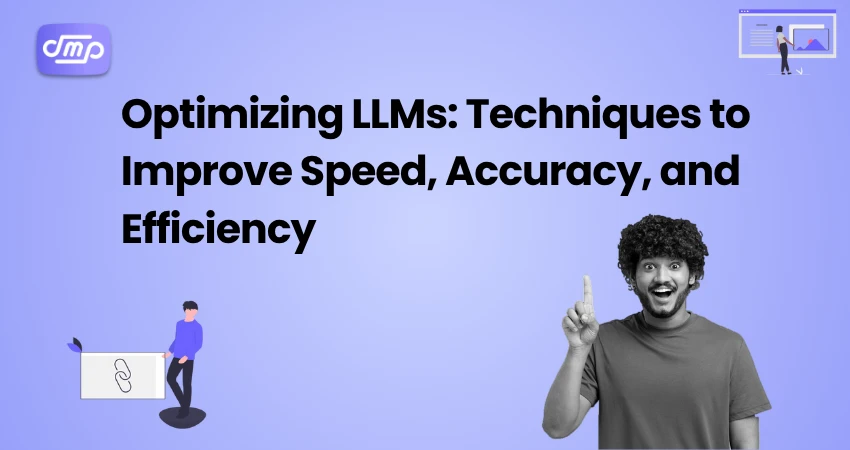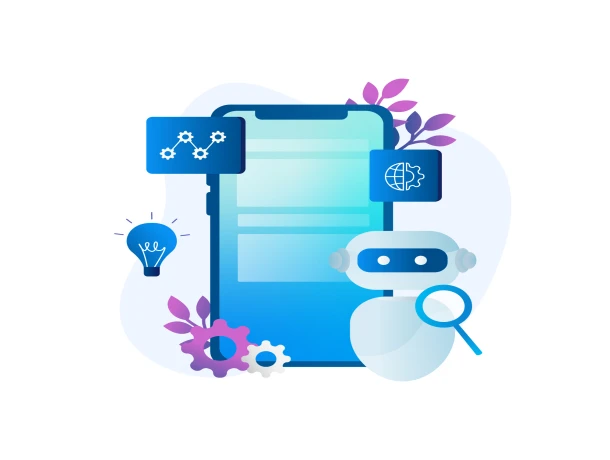
- August 8, 2025
- Digital Marketing, seo
- Digital Marketing
Table of Contents
Large Language Models (LLMs) like GPT-4, LLaMA, and PaLM have altered modern AI applications, including content development, customer service, data analysis, and language translation. However, these powerful machines come with significant drawbacks: they are huge, slow, and costly to operate. That’s where Optimizing LLM comes into its own.
LLM optimization entails using strategies to increase model speed, improve accuracy, and reduce resource use while maintaining performance.
Why Optimizing LLM Matters
As the use of Large Language Models (LLMs) spreads throughout industries, their sheer size and complexity present considerable hurdles. Models such as GPT-4, Claude, and LLaMA can include hundreds of billions of parameters, making them extremely powerful—but also computationally expensive, energy-intensive, and potentially unsuitable for real-time applications. This is when Optimizing LLM becomes not only necessary, but critical.
Here are the main reasons why optimizing LLMs matters:
- Improved Inference Speed: Unoptimized LLMs frequently have excessive latency during inference, which is unsuitable in time-sensitive settings like customer assistance, voice assistants, and live translation systems. Optimization approaches like as quantization and quick engineering greatly minimize reaction time, resulting in more fluid and user-friendly interactions.
- Lower computational costs: Running big LLMs requires significant GPU/TPU resources, resulting in soaring cloud bills. Businesses can save tens of thousands of dollars per month by using model compression and efficient deployment techniques—all while maintaining performance. Optimization supports long-term AI practices that are aligned with corporate goals.
- Enhanced Scalability: Using a full-sized LLM for each client interaction is not scalable. Optimized models, particularly distilled or quantized versions, are lighter and more versatile, allowing for scalable deployment across multiple platforms, devices, and user bases. This is especially important for startups and businesses wanting to roll out AI solutions at scale.
- Reduce energy consumption: As sustainability becomes more important, improving LLMs helps lower the energy footprint associated with model training and inference. Smaller, more efficient models use less electricity, which aligns with green AI concepts and business ESG objectives.
- Broader Accessibility: Optimizing LLMss can be deployed on devices with limited resources, such as smartphones, wearables, and edge computing devices. This makes advanced AI capabilities more accessible to customers without having a continuous online connection, enabling new use cases in healthcare, logistics, and field services.
- Improved User Experience: Users want quick, precise, and coherent solutions. Optimization has a direct impact on service quality since it ensures real-time replies, improved output correctness, and consistency across interactions. Optimizing LLMs can generate responses that are more natural and contextually aware.
- Domain-Specific Performance: General-purpose LLMs frequently lack clarity in specialized sectors such as law, medicine, and finance. Fine-tuning and transfer learning, two cornerstones of optimization, enable models to perform more relevantly and accurately in certain areas, hence increasing their practical utility.
Optimizing LLM is more than just making models smaller or faster; it is also about making them feasible, scalable, and impactful in the real world. It takes LLMs from research prototypes to production-ready engines of innovation.
Key Techniques for Optimizing LLM

Optimizing LLMs requires a multidimensional strategy that considers model architecture, inference behavior, memory efficiency, and even prompt design. These strategies are utilized to reduce computational burden, improve latency, lower costs, and increase accuracy, making LLMs production-ready for a wide range of situations. The following are the key strategies that define effective LLM optimization.
1. Model Compression
Model compression is the foundation of LLM optimization. It focuses on reducing the size of the model while preserving performance.
- Quantization: Quantization reduces the numerical precision of model weights and activations. For example, a model trained with 32-bit floating-point (FP32) values can be transformed to 16- or 8-bit integers. This significantly reduces memory use and accelerates inference. The model’s weight tensors are recalculated to fit in lower-bit formats. Advanced quantization approaches, such as post-training quantification or quantization-aware training, aid in performance retention.Ideal for applications where latency and memory are critical, such as edge deployment or real-time inference.
- Pruning: Pruning removes superfluous weights or neurons that add little to output. This results in a sparser network, which speeds up training and inference. Structured pruning removes entire layers or attention heads. Unstructured pruning removes individual weights below a predetermined threshold.
- Knowledge Distillation: Knowledge distillation entails teaching a smaller “student” model to mimic the behavior of a bigger “teacher” model. The learner learns to emulate the teacher’s outputs (logits or soft labels), thereby capturing knowledge in a learner architecture.
2. Fine-tuning and Transfer Learning
Fine-tuning is a crucial technique for improving LLM performance in domain or task-specific settings. Rather than beginning from scratch, engineers modify a previously trained model for a new dataset.
- Full fine-tuning: The entire model is trained using a new dataset. This can produce excellent results, but it is computationally intensive and may lead to overfitting if the dataset is limited. Examples include fine-tuning GPT on legal documents to build a legal assistant.
- Parameter-Efficient Fine Tuning (PEFT): Rather than updating all model parameters, PEFT approaches concentrate on tiny, trainable portions of the model. LoRA (Low-Rank Adaptation) adds low-rank matrices to each transformer layer. Adapters add small, trainable modules between layers. Benefits include reduced memory utilization and faster training cycles. Ideal for organizations with limited GPU access or large-scale multi-domain deployments.
3. Inference Optimization
Training is only half of the game; optimizing LLM inference is critical for achieving real-world performance. Inference optimization entails setting hardware, software, and runtime environments to maximize performance while minimizing latency.
- Hardware Acceleration: Models can be deployed on specialized hardware such as GPUs, TPUs, or NPUs, which speeds up matrix operations. Tools such as CUDA, TensorRT, and XLA (Accelerated Linear Algebra) can help to improve execution.Cloud platforms include AWS Inferentia, Google TPU, and Azure AI Accelerators.
- Batching and Parallelism: Batching enables numerous input requests to be processed concurrently, increasing GPU utilization. Real-time request grouping (used in the NVIDIA Triton Inference Server). Pipeline parallelism and model sharding enable distributed inference across several devices.
- Optimized Runtimes Libraries, and toolkits include: Cross-platform and hardware-agnostic. TensorRT is NVIDIA’s high-performance inference engine. Triton Inference Server supports auto-batching and ensemble models. These decrease overhead, increase speed, and improve integration in production environments.
4. Memory and Latency Management.
Memory optimization is critical for implementing LLMs on restricted devices or managing high-throughput applications.
Techniques include:
- To conserve RAM, use lazy loading to load model components only when needed.
- Memory Offloading dynamically transfers sections of the model between the CPU and GPU.
- Model sharding involves distributing huge models over numerous devices or nodes.
- Tensor Fusion combines operations to reduce intermediate memory allocations.
All of these strategies help to optimize LLM for real-time and edge settings, ensuring that models function smoothly without crashes or slowdowns.
5. Prompt Engineering
Prompt engineering is a lightweight yet effective optimization technique. It focuses on creating input prompts that increase the relevance, accuracy, and efficiency of model results.
Best practices:
- Be Explicit: Define the task in the prompt.
- Use examples: Few-shot learning improves performance on specialized activities.
- Trim Tokens: Shorten prompts to reduce token consumption and cost.
- Control Tone and Style: Structure prompts to fit the desired output format (for example, formal tone and bullet points).
In serverless or API-based LLMs (such as OpenAI’s), better prompt design can significantly cut response time and token costs, making it an easy win in LLM optimization.
6. Cache and Reuse Strategies
Repeated or similar inquiries are common in real-time LLM systems such as search engines or chatbots. Caching findings and intermediate states (such as attention maps) can help to reduce redundancy in processing. Token-level caching involves reusing outputs for recurrent sequences. Embedding caching saves vector representations of frequently used inputs.
These strategies considerably improve speed and efficiency, particularly in applications with large repeat query rates.
Challenges of Optimizing LLM

While optimizing LLM is beneficial, it also presents obstacles.
- Tradeoffs: Speed and accuracy must be carefully adjusted.
- Deployment complexity: Hardware-aware optimization necessitates specialist knowledge.
- Ongoing maintenance: Models must be re-optimized as requirements change.
Conclusion
In an increasingly AI-dependent world, optimizing LLM is no longer optional—it’s critical. From compression and quantization to rapid engineering and hardware acceleration, the correct optimization approaches can help developers create quicker, smarter, and more efficient LLM applications.
Whether you want to cut costs, increase latency, or boost accuracy, Optimizing LLM is your road to creating dependable and scalable AI systems that are ready for tomorrow’s needs.











